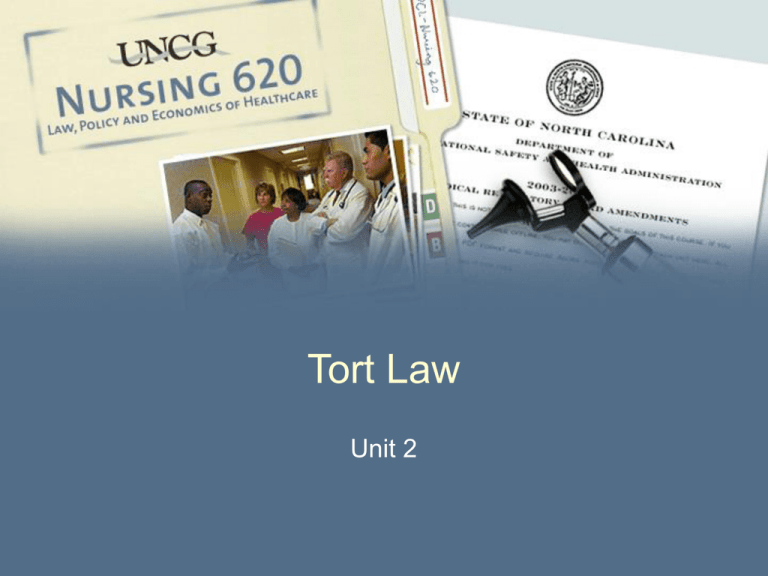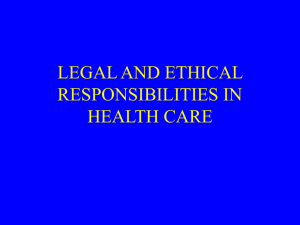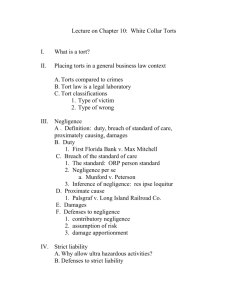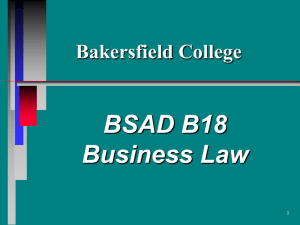Patient Rights
advertisement

Tort Law Unit 2 Negligence Conduct lacking in due care Carelessness 2 Deviation from standard of care that a reasonable person would use in a particular set of circumstances Doing something that the reasonable and prudent person would not do Applies to professionals as well as other non professionals Malpractice Tortfeasor (person committing civil wrong) must be a professional Professional misconduct Unreasonable lack of skill or fidelity in professional or judiciary duties Evil practice Illegal or immoral conduct 3 Malpractice Continued 4 Results in injury or unnecessary suffering or death of patient Proceeds from ignorance, carelessness, want of professional skill, disregard of established rules and principles, neglect, or a malicious or criminal intent Establishment of Liability 5 Duty owed the patient: reliance relationship, care owed of reasonably prudent nurse judged by expert testimony, published standards, and common sense Breach of the duty owed the patient - deviation from standard care Foreseeability: what reasonably could be expected Establishment of Liability Continued 6 Causation: Cause in fact - breach of duty owed caused injury; proximate cause - how far liability extends for consequences of action Injury - physical, emotional, financial Damages: General damages inherent in case; special damages such as losses, expenses; emotional damage; punitive damage Doctrine of Res Ipsa Loquitor Let the thing speak for itself 7 Doctrine allows a negligence cause of action without all six elements Must prove causation, injury, damages Used in cases where for example patient was unconscious in surgery Locality Rule Professional viewed by a prevailing community standard Has been abolished in most cases 8 Judicial Law: Idaho Supreme Court Buck v. St. Clair (1981) Locality Rule Abolished Availability of mass media Professional organizations and standards Standards for accreditation of hospitals 9 Intentional Torts Tort: civil wrong committed against a person or person’s property Not based on contracts Three elements: Volitional act by the defendant (not omission) 10 Intent to bring about consequences or appear to have intended to bring about consequences Intentional Torts Continued 11 Causation - act must be substantial factor in bringing about injury or consequences (damages need not be incurred) Examples of Torts 12 Intentional torts: assault, battery, false imprisonment, conversion of property Quasi-intentional torts: defamation of character, invasion of privacy Assault 13 Apprehension of unwarranted touching Battery Harmful or unwarranted contact with the plaintiff-patient Single touch sufficient for tort No harm or injury need occur to the patient Patient need not be aware 14 Causation through direct or indirect contactexample: nurse dropping a tray Battery Continued Unwarranted touching of patient belongings Lack of consent most common cause 15 False Imprisonment 16 Unjustifiable detention of person without legal warrant to confine person Must be knowledge of imprisonment by patient for it to occur Incompetent, mentally ill, or persons posing a threat to society may be detained against will Conversion of Property Interference with right to possession of patient’s property Need to have adequate justification of action 17 Intentional Infliction of Emotional Distress Professional conduct goes beyond that tolerated by society Conduct calculated to cause mental distress Conduct causes mental distress 18 Invasion of Privacy 19 Unreasonable unwarranted interference with individual's solitude Patient has right against 1) Appropriation of plaintiff’s name or picture for defendant’s sole advantage; 2) Intrusion by defendant upon patient’s seclusion or affairs; 3) Publication by the defendant of facts that place the patient in a false light; 4) Public disclosure of private facts about the patient by hospital staff or medical personnel Defamation Comprised of slander (oral) and libel (written) Wrongful injury to another’s reputation Five elements Defamatory language that adversely affects reputation Defamatory language concerning living person 20 Defamation Continued Publication to a third party or several persons Damage to person’s reputation 21 Fault on part of defendant in writing or telling another the defamatory language Defenses against intentional torts 22 Consent or implied by law through: prevention of loss of life or limb; person incapable; no reasonable reason to believe consent would not be given; reasonable person in similar circumstances would give consent Truth in defamation cases Defenses Against Torts Continued 23 Privilege - to protect public and private interests. Example - recommendation from former to prospective employer; appropriate channels used; truthful; objective terms Disclosure Statutes: reporting of information for health reasons Intentional torts mitigated by retraction, if provoked Defenses to Nonintentional Torts 24 Release: only compensated for negative action Contributory negligence: patient contributes to negative action Assumption of risk: Plaintiff understood and is partially responsible Immunity Statutes: Example - Good Samaritan Law Statute of Limitation 25 In most states, 2 to 4 years, or with a child, until age of maturity In North Carolina, 3 years for most cases Informed Consent 26 Expressed or implied; written or oral, complete or partial Major exceptions: Emergency , therapeutic privilege, patient waiver, prior patient knowledge or common knowledge Other exceptions: preservation of life, protection of minors, prevention of self destruction, maintenance of ethical integrity, protection of public’s health





